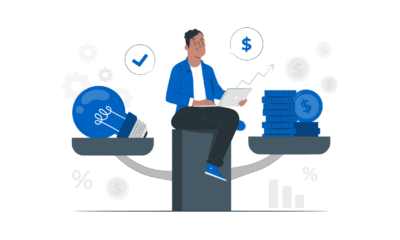BUSINESS
The Importance of Cybersecurity Framework Compliance in the Digital Age

Key Takeaways:
- Cybersecurity frameworks are indispensable in securing digital assets and are increasingly acknowledged globally.
- Understanding and implementing the CMMC framework is crucial for organizations within the defense sector.
- Microsoft 365’s security capabilities are instrumental in achieving compliance, offering streamlined solutions to meet framework requirements.
Table of Contents:
- Understanding Cybersecurity Frameworks and Their Relevance
- The Role of CMMC in Enhancing Cybersecurity Posture
- Aligning Microsoft 365 With Cybersecurity Frameworks
- The Importance of Compliance in Modern Business Operations
- Best Practices for Achieving and Maintaining Compliance
- Emerging Trends in Cybersecurity and Compliance
- Assessing the Economic Impact of Compliance
- Choosing the Right Tools for Compliance
- Successful CMMC Compliance with Microsoft 365
Understanding Cybersecurity Frameworks and Their Relevance
Cybersecurity frameworks serve as critical benchmarks, providing structured approaches for organizations to protect digital landscapes. Acknowledging their role in safeguarding data against a backdrop of escalating cyber threats, these frameworks offer comprehensive controls that assist businesses in establishing a baseline for security practices. By adhering to these standards, organizations can protect their assets and maintain the confidentiality, integrity, and availability of sensitive information.
Adopting cybersecurity frameworks is widely recognized as essential in the mosaic of global cyber defense. These frameworks support international collaboration against cybercrime, supplying common languages and standards for multinational entities. Their universality transcends borders and industries, uniting efforts to combat cyber adversaries that, too, operate without regard for geographic limitations.
Beyond their theoretical underpinnings, the practical applications of cybersecurity frameworks are profound. Companies that overlook their significance might find themselves suffering dire consequences, as seen in recent high-profile cyber attacks that have led to crippling financial ruin and reputational harm.
The Role of CMMC in Enhancing Cybersecurity Posture
In the US defense contracting terrain, the CMMC is a vital measure in the crusade to safeguard against cyber threats. Encompassing a tiered matrix of security practices, the framework aims to fortify defense contractors against malicious cyber activities, thereby ensuring the integrity of the defense supply chain. With clear standards and requirements, CMMC provides businesses a pathway toward achieving higher cybersecurity maturity levels, exponentially reducing their susceptibility to cyber intrusions.
Embracing the CMMC framework confers immense benefits upon organizations by elucidating a pathway for enhancing cybersecurity practices. It fortifies their defense against virtual adversaries and facilitates their eligibility for contracts with the Department of Defense (DoD), effectively marrying compliance with potential business growth. As a result, pursuing CMMC certification is less an optional undertaking than a strategic business imperative. By incorporating a CMMC compliance checklist into their cybersecurity strategies, organizations can methodically navigate this framework’s complexities and address requisite benchmarks with precision and attention to detail.
Aligning Microsoft 365 With Cybersecurity Frameworks
As an industry-leading productivity and collaboration tool, Microsoft 365 extends its versatility to cybersecurity. Its suite of solutions, encompassing proactive threat protection and advanced compliance capabilities, is designed to meet the rigorous demands of various cybersecurity frameworks. These inbuilt features empower users to confront cyber threats more effectively, integrating seamlessly into their daily operations to create a fortified digital environment. For organizations navigating the compliance landscape, Microsoft 365 emerges as an ally, significantly easing the burden of maintaining a stringent cybersecurity posture. The suite’s comprehensive security offerings are not mere byproducts but are strategically crafted to serve the complex needs of highly regulated industries, including government contracting and healthcare. Such alignment with cybersecurity frameworks, including CMMC, HIPAA, and GDPR, affirms Microsoft 365’s commitment to secure computing.
By leveraging the extensive compliance offerings of Microsoft 365, entities can confidently tackle the intricacies of the CMMC framework, ensuring that their methodology for managing information flows and guarding against cyber threats accords with recognized best practices.
The Importance of Compliance in Modern Business Operations
In the contemporary business milieu, compliance with cybersecurity frameworks has become a linchpin for maintaining trust and operational viability. Clients, partners, and regulators demand assurances that organizations responsibly manage and protect sensitive data. This heightens the need for businesses to showcase their commitment to robust cybersecurity strategies through strict adherence to frameworks such as CMMC, ISO 27001, and NIST standards.
Ignoring compliance mandates can have grave ramifications, leading businesses to steep regulatory fines, costly data breaches, and irreparable brand damage. Companies can avoid these pitfalls by viewing compliance as a set of obligations and a strategic advantage. Documented compliance successes, shared through transparent case studies, demonstrate how security-focused organizations can achieve resilience while fostering market differentiation and consumer trust.
Best Practices for Achieving and Maintaining Compliance
To embark on a successful compliance journey, an organization must first ascertain the cybersecurity frameworks that pertain to its sector and operational scope. This entails carefully analyzing the organization’s unique facets and the sensitive data it handles, followed by a targeted selection of control measures from the respective framework. Crafting an action plan that effectively aligns with these frameworks is a compliance exercise and a strategic initiative supporting an organization’s security posture.
However, the cybersecurity landscape is ever-changing, necessitating a multipronged assurance strategy. Pursuing initial compliance should be viewed as the beginning rather than the culmination of an organization’s security commitments. Persistent vigilance and iterative improvements to the security infrastructure’s technical and procedural elements are mandated by the dynamic nature of digital threats. Besides the formal aspects of a compliance strategy, cultivating a workforce that’s well-informed on cybersecurity threats and their implications ensures a robust internal defense against potential incidents.
Emerging Trends in Cybersecurity and Compliance
As we pivot towards a more interconnected digital economy, the cybersecurity landscape is continually being reshaped by innovative technologies and emerging threat vectors. The advent of cloud computing and the Internet of Things (IoT) has expanded the digital perimeter, compelling a reevaluation of conventional security models. Compliance frameworks must evolve with these technological shifts to address the novel risks they present and ensure these complex systems’ successful governance.
The adaptability of cybersecurity strategies is paramount as organizations seek to defend against a sophisticated and ever-evolving barrage of cyber threats. New compliance requirements, technologies like encryption, and AI-driven security solutions are at the forefront of this adaptive response. It is incumbent upon organizations to be astute observers of these trends and to be proactive in aligning their cybersecurity initiatives accordingly to safeguard their digital infrastructure and stakeholder interests.
Assessing the Economic Impact of Compliance
Organizations often grapple with cybersecurity compliance’s financial implications, which can be particularly pronounced for smaller enterprises. Yet, an informed evaluation reveals that prudent investment in cybersecurity measures to achieve compliance can forestall substantial financial repercussions. Implementing frameworks like CMMC reduces the likelihood of cyber incidents and enhances the organization’s reputation, opening the doors to new business opportunities, particularly within the government contract realm.
The imperative to invest in compliance mechanisms remains a strategic decision rooted in a long-term perspective. Empirical evidence suggests a robust compliance framework is an invaluable bulwark against the potentially exorbitant costs of breaches, regulatory penalties, and operational disruptions. Thus, a forward-looking viewpoint situates compliance not as an onerous cost but as a shrewd maneuver for risk aversion and a conduit to a secure and prosperous future.
Choosing the Right Tools for Compliance
Effective compliance management hinges on selecting the appropriate technological tools, which requires strategic foresight and practical functional considerations. Organizations must weigh the merits of potential solutions through the lens of scalability, user experience, and their ability to augment existing systems seamlessly. Given the critical nature of this selection, tools must be evaluated for their precision in addressing specific framework mandates, with a tilted preference towards those that facilitate streamlined procedures and assure compliance integrity.
The ascendancy of automation in compliance management is unmistakable, given its potential to refine process efficiency, enhance accuracy, and free up valuable resources. Such automated compliance tools are force multipliers within an organization’s cybersecurity arsenal, translating complex compliance requirements into achievable, routine tasks. Platforms such as Microsoft 365 exemplify the convergence of productivity enhancement and compliance facilitation—a commendable synergy that modern enterprises can leverage in their quest for cybersecurity excellence.
Successful CMMC Compliance with Microsoft 365
Exploring real-world applications wherein entities successfully bridge the compliance chasm offers invaluable insights. One illustrative example entails a defense contractor’s journey toward CMMC compliance, enabled by Microsoft 365’s compliance capabilities. This case study unveils the strategic integration of the CMMC framework within the organization’s processes, empowered by the enterprise-grade security solutions of Microsoft 365. The effective alignment between CMMC requirements and the security offerings of the productivity suite underscores its pivotal role in facilitating compliance.
In parsing the lessons drawn from this case study, several themes emerge, notably the indispensability of executive support and tactical planning in forging a compliance-centric organizational ethos. Moreover, the criticality of nurturing a knowledgeable workforce capable of navigating the intricacies of cybersecurity frameworks is accentuated. Indeed, the demand for cybersecurity expertise underscores the pressing need for skilled personnel in the formulation and execution of compliance strategies—a central pillar in attaining cybersecurity maturity.
BUSINESS
Data Detectives: How Your Participation in Clinical Trials Advances Medical Science
Key Takeaways:
- Understanding the integral role of clinical trials in medical progress.
- Recognizing the benefits and risks of clinical trials to participants.
- The ethical considerations and the importance of informed consent.
- How data from trials can shape the future of healthcare.
Table of Contents:
- The Foundations of Clinical Trials
- Volunteer Engagement: The Heart of Discovery
- Demystifying the Clinical Trial Process
- The Significance of Informed Consent
- Efficiency and Ethics: The Dual Priorities
- Behind the Scenes: Data Analysis in Trials
- Impact on Future Medicine
- How to Become a Clinical Trial Volunteer
The Foundations of Clinical Research
Clinical research is the critical cornerstone of medical advancements, reflecting the symbiosis between scientific rigor and human volunteerism. These protocols are essential for ascertaining emerging medical interventions’ safety and efficacy and ensuring continued treatment options development. The grounding principle of any clinical trial is the structured framework that guides its processes. This framework is methodically designed and subject to intense scrutiny by regulatory bodies, ensuring that new therapies are effective and safe for the populace. The structured nature of clinical research allows professionals to take logical and measured steps toward breakthroughs in medical science.
Volunteer Engagement: The Heart of Discovery
At the fulcrum of all clinical research efforts are the trial participants themselves. These individuals, often called volunteers, play an invaluable role in discovering new treatments. By agreeing to partake in trials, they provide a service that transcends personal benefit. They contribute to a broader societal good, encompassing enhanced knowledge about disease processes, potential treatments, and therapeutic interventions. Acknowledging the benefits and risks of clinical trials is pivotal to participant involvement. Volunteers are thoroughly briefed on possible side effects, anticipated outcomes, and the crucial nature of their contribution, thus enabling them to make informed decisions and be active, informed contributors to the trial process.
Demystifying the Clinical Trial Process
Many people may find the clinical trial process opaque and complex, fraught with scientific jargon and intricate procedures. Breaking down these barriers to understanding is crucial for enhancing public engagement and transparency. It is typically segmented into a series of phases, each meticulously design to serve a particular purpose. Phase I trials act as a safety check for a new intervention on a limited number of participants, while Phase II studies involve a larger group to evaluate its effectiveness. After completing these stages, Phase III trials are conducted on a larger scale, comparing the intervention with existing treatments to establish superiority or equivalence.
The Significance of Informed Consent
Informed consent is a crucial pillar of clinical research, acting as a gateway for participant autonomy and safety. This process involves educating potential participants about the clinical trial understandably and comprehensively. The informed consent form details every aspect of the trial, such as the nature and purpose of the research, anticipated risks and benefits, alternative procedures or treatments, and the participant’s rights, including the right to withdraw from the trial at any time. This transparency protects the volunteer and fosters an environment of trust and ethical practice within the trial. Allowing participants to enter the study with a complete understanding of their involvement is a moral obligation and cornerstone of compassionate research practices.
Efficiency and Ethics: The Dual Priorities
Clinical research operates on two inextricably linked priorities: efficiency in data collection and unwavering commitment to ethics. Researchers seek to obtain robust and high-quality data that can withstand scrutiny and form the basis for medical guidelines and treatment protocols. Simultaneously, the ethical considerations in clinical trials encompass participant privacy, informed consent, risk minimization, and the equitable selection of research subjects. These measures ensure that pursuing scientific knowledge does not compromise human dignity and respect for individual rights.
Behind the Scenes: Data Analysis in Trials
The success of clinical research is inherently tied to the meticulous analysis of the data it generates. Teams of statisticians and data scientists work in the background, sifting through vast amounts of information to identify trends, outcomes, and potential issues. The data analysis phase is meticulous and delicate, as it holds the key to validating the effectiveness of new medical interventions. During this phase, the results are interpreted to derive conclusions that could impact the availability of new treatments to patients worldwide.
Impact on Future Medicine
Clinical research is significant because it opens the possibility of new treatments and lays the groundwork for future innovations. Successful clinical trials have far-reaching implications; they inform clinical guidelines, contribute to scientific literature, and can significantly alter the course of patient care. In this sense, the data obtained from clinical trials is a valuable asset that can influence healthcare policy, funding allocations, and the standard of care delivered to patients globally for generations to come.
How to Become a Clinical Trial Volunteer
For those considering altruistic involvement in clinical trials, the path begins with understanding the eligibility criteria for participation and the depth of the commitment needed. Prospective volunteers should gather information on available trials that match their interests or conditions. The next step usually involves a pre-screening or an initial discussion with the trial coordinators, who provide detailed information on the trial’s scope and expectations. Making an informed decision to volunteer is not just a personal choice but a potential contribution to the collective medical advances.
For more information on the ethical and procedural nuances of clinical trials, interested individuals can consult global health authorities that offer resources and fact sheets for public education.
It’s critical to keep up with the most recent advancements in clinical research. News outlets often provide insightful coverage of current clinical trials and the strides in medical science, which can serve as a rich resource for learning about ongoing advancements.
BUSINESS
Winning in the Digital Aisle: Cutting-Edge Strategies for Grocery Success

Traditional grocery business models are being disrupted due to an extensive digital transformation, demanding a strategic re-think of retail practices. Companies need to stay relevant by adopting innovative strategies and embracing technological advancements. Within this evolutionary phase, loyalty programs have transcended their conventional role as dynamic tools for fostering customer fidelity and driving sophisticated marketing tactics. This article delves into practical and innovative methodologies that grocery businesses can capitalize on to flourish in today’s volatile market.
Table of Contents:
- Personalization in Grocery Shopping
- Enhanced Online Presence and E-commerce
- Supply Chain Optimization for Grocers
- Emerging Payment Systems in Grocery Retail
- Grocery Delivery Innovations
- Utilizing Big Data for Customer Insights
- Sustainability Practices in Modern Grocery Businesses
- Community Engagement and Support Strategies
- Conclusion
Personalization in Grocery Shopping
The importance of personalization in grocery shopping is rising as stores work to accommodate each customer’s unique requirements and preferences. With the integration of grocery loyalty programs, retailers can offer personalized discounts, recommendations, and incentives based on shopping habits and preferences. By analyzing data from loyalty programs, retailers can tailor promotions and offers to specific customers, enhancing their shopping experience and fostering loyalty. Customization boosts customer happiness and encourages recurring business by making them feel appreciated and understood. Personalization will become increasingly important in determining the future of grocery shopping as technology advances.
Enhanced Online Presence and E-commerce
Grocery companies must prioritize developing a solid online presence and making e-commerce infrastructure investments as more and more customers shop online for convenience and accessibility. This includes creating user-friendly mobile applications and websites that provide safe payment methods, easy navigation, and seamless browsing. Additionally, implementing click-and-collect or home delivery services enables customers to shop for groceries conveniently from their preferred devices. Grocery companies may reach a larger audience, adjust to changing consumer preferences, and profit from the expanding demand for online grocery shopping by embracing e-commerce.
Supply Chain Optimization for Grocers
Competent supply chain management is proving to be a cornerstone for ensuring the availability and freshness of products – attributes that drive a grocery store’s reputation and profitability. Advancements in real-time tracking, predictive analytics, and automated procurement systems have enabled grocers to control their inventories meticulously. As demand forecasting becomes more precise, grocery businesses can reduce overheads and avoid oversupply, thus championing sustainability and operational efficiency. Optimized supply chains are influential in maintaining product integrity and providing complete transparency from farm to fork, which is vital in securing consumer trust.
Emerging Payment Systems in Grocery Retail
Integrating innovative payment solutions within the grocery retail space underscores a commitment to convenience and customer satisfaction. The emergence of diverse payment solutions, such as mobile wallets and contactless card technologies, has set a new standard for transaction ease and speed. The rapid embrace of such payment mechanisms is a testament to the sector’s agility and focus on consumer-centric innovation. By simplifying payment processes, grocers enhance the shopping experience and drive efficiency in operational workflows – a dual advantage that can significantly improve the bottom line.
Grocery Delivery Innovations
The delivery service domain within grocery retail has witnessed transformative innovations driven by consumer demands for immediate and flexible service. Modern grocery delivery ventures encompass traditional home delivery and expedited services and subscription models that ensure a regular supply of household staples. Innovative logistics solutions are being explored, from crowd-sourced delivery networks to autonomous delivery bots and drones that promise to redefine convenience. These advancements optimize resource allocation and revolutionize the consumer’s perception of grocery fulfillment.
Utilizing Big Data for Customer Insights
A significant data era has sprouted unprecedented opportunities for grocery businesses to dial into deep customer insights. A strategic analysis of datasets encompassing sales figures, customer demographics, and purchasing behaviors leads to actionable intelligence that can guide everything from stock management to promotional ordeals. Grocery businesses that harness the power of big data analytics set themselves up for a future where retail strategies are data-driven and customer-centric, thus vastly outperforming competitors still reliant on traditional intuition-based practices. This data-oriented approach provides a bird’s eye view of the grocery market, allowing retailers to anticipate future trends and react swiftly.
Sustainability Practices in Modern Grocery Businesses
Sustainability has surfaced as a principal factor influencing consumer choices, and grocery stores increasingly embrace sustainable business practices. Initiatives around reducing carbon footprints, minimizing waste, and fostering local ecosystems exemplify a commitment to environmental stewardship. Retailers are positioned as champions of green initiatives by providing reusable packaging, energy-efficient store designs, and an emphasis on lowering the carbon emissions connected with logistics. Such practices resonate with consumer values and secure long-term resilience by aligning with global sustainability objectives.
Community Engagement and Support Strategies
Strengthening community ties through active engagement and support is an essential strategic pillar for grocery stores aspiring to become local staples. Through community-centric programs, neighborhood collaborations, and partnerships, grocery businesses underscore their role as critical contributors to local welfare. Supporting farmers’ markets, localizing supply chains, and participating in community events authentically demonstrates the grocery sector’s commitment to the societal fabric. These actions engender goodwill and a shared sense of purpose, fostering robust bonds with the communities they serve.
Conclusion
As the article unearths the pivotal role of digital transformation in shaping the grocery retail sector’s trajectory, it is clear that technology and innovation walk hand-in-hand with enhanced customer satisfaction and sustainable business practices. Seamless integration of online platforms, personalized experiences, supply chain intelligence, novel payment options, big data analytics, delivery logistical advancements, environmental stewardship, and community involvement encapsulate the manifold strategies underpinning the thriving grocery industry. These initiatives commend grocery businesses for their adaptability and point towards a future where technology and personal touch blend to transform the way we perceive grocery shopping.
BUSINESS
How CRM Solutions Can Boost Your Sales and Customer Relationships
Key Takeaways:
- CRM systems provide a solid infrastructure for sales teams to deliver data-driven results.
- Nurturing customer relationships is a key feature of CRM, driving loyalty and repeat business.
- CRM innovation and proper implementation contribute to business growth and customer satisfaction.
Building strong customer relationships in today’s competitive business landscape is no longer optional – it’s essential. Customer Relationship Management (CRM) solutions have emerged as powerful tools to help businesses achieve this goal.
The Catalyst of Customer Management: CRM at the Core of Sales Success
The business landscape is constantly in flux, driven by innovation and customer expectations. To stay competitive, companies harness CRM solutions’ power to manage customer interactions and transform them into actionable insights for sales strategy refinement. The integration of a quality CRM system, overseen by an adept Salesforce consultant, is now recognized as a fundamental component of any business strategy focused on growth. These sophisticated platforms offer insights, automation, and customer data that can shift the mainstream sales paradigm into a more personalized and engaging experience for the customer, enhancing satisfaction and loyalty in the process.
The Data-Driven Sales Strategy: Utilizing CRM for Market Insight
Arguably, one of the strongest attributes of CRM is its ability to generate valuable market insights from vast amounts of customer data. When leveraged appropriately, these insights guide the creation of effective, targeted sales strategies. By understanding customer demographics, purchasing habits, and overall satisfaction, businesses can create an experience that feels bespoke to each consumer.
Sales Performance Tracking: Analyze sales metrics and identify areas for improvement. Track individual and team performance, allowing you to identify top performers and implement effective sales strategies.
Customer Behavior Analysis: Gain insights into customer behavior and buying patterns. This knowledge can be used to personalize marketing campaigns, develop targeted product offerings, and improve overall customer experience.
Data-Backed Decision Making: Make informed business decisions based on real-time data and customer insights. CRMs empower you to identify sales opportunities, predict customer needs, and optimize your sales strategy for maximum impact.
Automating the Routine: Streamlining Sales Processes with CRM Tools
Repetitive tasks can hamper a sales team’s efficiency. CRM tools offer the solution by automating mundane activities such as appointment scheduling, lead scoring, and follow-up emails. This automation ensures a continuous and consistent customer experience by remediating human limitations. It provides a foundation for sales teams to operate with agility, focusing their attention where it truly matters: building meaningful customer relationships and meticulously crafting deals.
Personalizing the Pitch: CRM and the Tailored Customer Experience
Today’s consumer has grown to expect personalization in their vendee-vendor interactions. CRM systems have become remarkable in segmenting customers based on distinct criteria, allowing customized marketing strategies. Imagine delivering the perfect promotional message at the optimal time to a curated group of customers – this is the precision CRM offers. Such individualized communication enhances the customer experience, often leaving a lasting impression that pays dividends through conversions and brand loyalty.
Fostering Loyalty: CRM as a Relationship Builder
CRM systems truly shine when they move beyond transaction-centric views to focus on building and maintaining strong relationships with customers. A well-maintained CRM system provides all the functionalities needed to develop and monitor customer retention strategies such as loyalty programs, personal follow-ups, and satisfaction surveys. Through these efforts, customers often feel more connected to a brand, appreciated, and listened to. This is essential in a marketplace where choice is abundant and switching brands is easier than ever.
Beyond Sales: The Ripple Effect of Effective CRM on Other Business Areas
The influence of a comprehensive CRM system reaches far beyond the realm of the sales department. Marketing teams can unleash precisely targeted campaigns based on the rich customer data within CRM. In contrast, teams can instantly pull up a customer’s history to provide informed, considerate service. This 360-degree approach to customer engagement fosters a culture of responsiveness and attentiveness that resonates across all facets of the business, resulting in a stronger brand and cohesive customer experience.
Up-to-the-Minute Trends: CRM Innovations on the Horizon
As CRM platforms evolve, they integrate advanced technologies like predictive analytics and artificial intelligence to enhance the user experience and provide deeper insights. Such innovations empower businesses to preempt customer needs and adapt swiftly to changes in the marketplace. Staying informed about these developments is vital for businesses aiming to keep their competitive edge.
Integrating CRM into Your Business: Steps to Success
Implementing a CRM system requires a meticulous approach to ensure the platform fits the business’s and its customers’ unique needs. The process begins with a thorough needs assessment, selecting a CRM with features and capabilities that align with specific business goals. Stakeholder engagement and comprehensive training are critical components, ensuring widespread adoption and minimizing resistance to change. Constant evaluation and adaptation of CRM practices allow businesses to remain agile and responsive as customer expectations evolve. By taking these considered steps, businesses pave the way for successful CRM implementation and the substantial advantages that come with it.
CRM systems are critical assets in a business’s toolset in a narrative where customer data and sales optimization are foundational to success. The partnership with an expert Salesforce consultant can illuminate the path to CRM success, where sales figures surge as customers enjoy increasingly customized and resonant experiences. A personalized approach, supported by a powerful CRM system, transforms the customer journey into one of true engagement, suggesting a single profitable transaction and a long-term relationship. In this way, CRM solutions drive sales and cultivate the grounds for consistent market relevance and customer satisfaction.
-

 LOVE MESSAGES5 months ago
LOVE MESSAGES5 months agoSweet Love Messages for Her to Make Her Smile
-

 LOVE MESSAGES5 months ago
LOVE MESSAGES5 months ago100 Romantic Good Evening Messages For Her & Him
-

 LOVE MESSAGES5 months ago
LOVE MESSAGES5 months agoRomantic Love Messages For My Husband With Images
-

 LOVE MESSAGES5 months ago
LOVE MESSAGES5 months ago50 Just Checking on You Text Messages for Him & Her
-

 LOVE MESSAGES5 months ago
LOVE MESSAGES5 months agoSweet Love Messages For My Wife With Images
-

 LOVE MESSAGES5 months ago
LOVE MESSAGES5 months agoLong Good Morning Messages to Make Her Fall in Love
-

 LOVE MESSAGES5 months ago
LOVE MESSAGES5 months ago50 Cute Good Night Sweet Dreams Messages For Lovers
-

 LOVE QUOTES3 months ago
LOVE QUOTES3 months agoplease forgive me quotes her him images








